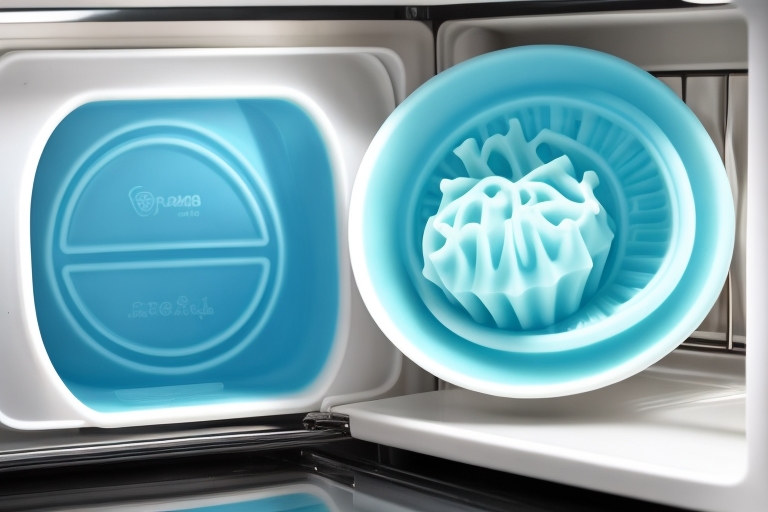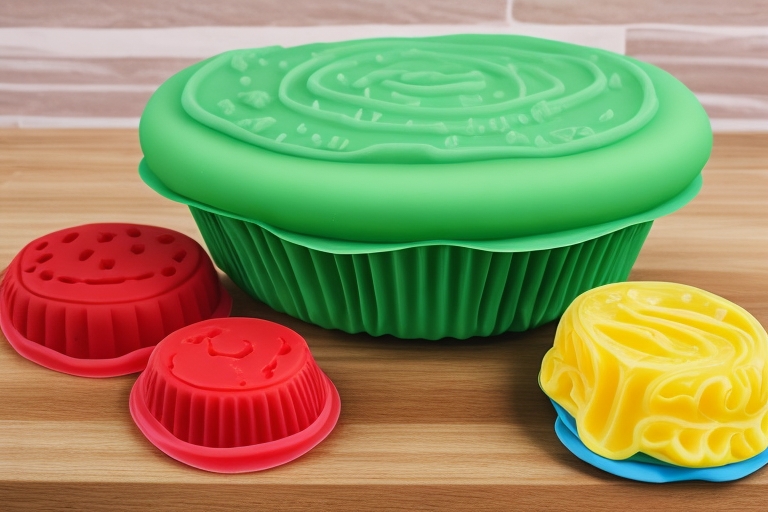
Yes, silicone food covers are safe to use in the microwave, as long as they are labeled as microwave-safe. it is important to follow the manufacturer’s instructions and use them according to the recommended temperature and time limits to avoid damage or potential safety hazards.
Silicone food covers have become kitchen superheroes in recent times. These versatile, stretchable wonders have taken the culinary world by storm, offering a convenient and eco-friendly alternative to traditional plastic wraps. Their ability to snugly fit over various containers of all shapes and sizes makes them a go-to choice for many households.
Today, we’re diving into a specific aspect of their utility—microwave safety. Picture this: you’ve covered your leftovers with a silicone food cover, and now you’re wondering, can it handle the heat of the microwave? Stick around as we unravel the mystery and explore whether these nifty kitchen accessories can withstand microwave magic.
What are silicone food covers?
Silicone Food Covers: Culinary Versatility Unveiled
Silicone food covers are ingenious kitchen accessories crafted from food-grade silicone, a flexible and heat-resistant material. These covers are designed to stretch and conform, providing a snug seal over various containers, including bowls, plates, and pans.
Purpose: The primary purpose of silicone food covers is to offer a sustainable and reusable alternative to traditional plastic wrap or aluminum foil. Their elastic nature allows them to fit a spectrum of container shapes and sizes, creating an airtight seal that helps preserve the freshness of food and protect it from external elements.

Benefits over Traditional Options:
- Eco-Friendly and Reusable: Silicone food covers champion sustainability by reducing the need for single-use plastic wraps. Their reusability not only minimizes environmental impact but also proves cost-effective in the long run.
- Versatility and Flexibility: Unlike rigid aluminum foil, silicone food covers are incredibly flexible. They can stretch to cover containers of different shapes, providing a versatile solution for various culinary needs. This adaptability makes them a favorite in kitchens where one-size-fits-all just doesn’t cut it.
- Airtight Seal: Silicone’s natural stickiness, coupled with its ability to stretch, enables these covers to create a reliable airtight seal. This seal not only keeps food fresh for longer but also prevents odors from permeating your fridge or mingling in the pantry.
- Microwave and Dishwasher Safe: Many silicone food covers are designed to be microwave-safe, allowing for convenient reheating of leftovers without the need for a container swap. Additionally, their dishwasher-safe nature simplifies the cleaning process, adding to the overall convenience.
- Durability and Heat Resistance: Silicone is known for its durability and heat resistance. It can withstand a range of temperatures, making it suitable for various kitchen applications, from covering hot pots on the stove to protecting food in the refrigerator.
Silicone food covers bring a blend of practicality, sustainability, and adaptability to the kitchen. As guardians of freshness and protectors against food waste, these covers have earned their place as a modern and eco-conscious alternative to traditional wrapping and sealing methods.
Microwave Safety and Silicone Food Covers
Navigating Microwave Safety with Silicone Food Covers
When it comes to microwaving, a few ground rules apply universally. First and foremost, always opt for microwave-safe products. But what about our trusty silicone food covers? Can they handle the microwave heat without breaking a sweat?
General Guidelines: Microwave safety revolves around choosing containers and covers that are explicitly labeled as microwave-safe. This label ensures that the material can withstand the heat generated by microwaving without leaching harmful substances into your food or causing the container to warp or melt.
Silicone’s Heat Resistance: The good news for silicone enthusiasts is that silicone is generally heat-resistant and can endure the temperatures generated by microwaving. This resilience makes silicone food covers a reliable choice for reheating your leftovers.
Silicone typically has a high heat resistance, often exceeding the temperatures reached in household microwaves. Its flexibility remains intact, and it doesn’t release any harmful chemicals when exposed to microwave radiation.
Check the Manufacturer’s Instructions: While silicone, in general, is microwave-friendly, it’s crucial to read and follow the specific guidelines provided by the manufacturer. Different silicone products may have slight variations in composition or design, influencing their microwave compatibility.
Pay attention to any labels or instructions that accompany your silicone food covers. Manufacturers often provide clear indications regarding their products’ suitability for microwave use. These guidelines ensure not only the safety of your food but also the longevity of your silicone covers.
The Label Speaks Volumes: Before you hit the start button on your microwave, take a moment to inspect the label on your silicone food cover. Look for any symbols or wording that indicate its microwave-safe status. This small precaution can prevent mishaps and ensure a seamless experience with your silicone kitchen companions.
In essence, silicone food covers are microwave-friendly, but a touch of diligence goes a long way. Stick to the guidelines, check the labels, and you can confidently let your silicone covers dance in the microwave heat, preserving both your food and the integrity of these versatile kitchen wonders.
How to use silicone food covers in the microwave
Mastering Microwave Magic with Silicone Food Covers
Step-by-Step Guide:
- Select a Microwave-Safe Container: Ensure that the container you’re using is labeled as microwave-safe. Silicone food covers work best when paired with microwave-friendly materials.
- Place Food in the Container: Load up your chosen container with the delicious fare you’re ready to reheat. From leftovers to fresh meals, silicone food covers are up for the task.
- Choose the Right Cover Size: Select a silicone food cover that comfortably fits over the top of your container. The stretchable nature of silicone allows for a snug fit on a variety of shapes, so find the size that suits your needs.
- Stretch and Cover: Hold the silicone food cover by its edges and stretch it over the container. Work your way around, ensuring a tight seal. The flexibility of silicone makes this a breeze, adapting to different shapes effortlessly.
- Ventilation Hole (Optional): Some silicone covers come with a ventilation hole. If yours has one, position it to allow steam to escape during microwaving. This helps prevent pressure buildup while keeping your food moist.
- Microwave at Medium Power: Opt for medium power settings on your microwave. This gentler approach reduces the risk of overheating, maintaining the structural integrity of both the cover and your meal.
- Use Short Bursts: If you need extended reheating, consider using shorter time intervals with breaks in between. This prevents excessive heat buildup and ensures even reheating without compromising the silicone.
- Check and Stir as Needed: Periodically pause to check the progress of your food. Stirring or rotating helps distribute the heat evenly, ensuring a consistent reheating process.
- Caution When Removing: Exercise caution when removing the silicone food cover after microwaving, as both the cover and the container may be hot. Use oven mitts or utensils to lift the cover away from the hot food.
Tips and Tricks:
- Check for Microwave-Safe Labeling: Always confirm that both the container and the silicone food cover are labeled as microwave-safe for a worry-free experience.
- Avoid High Power Levels: Stick to medium or medium-low power settings to prevent overheating and potential damage to the silicone cover.
- Experiment with Ventilation: If your cover has a ventilation hole, play around with its positioning to find the right balance between steam release and moisture retention.
By following these simple steps and tips, you can harness the full potential of silicone food covers in the microwave, ensuring convenient and safe reheating of your favorite culinary creations.
Alternatives to silicone food covers in the microwave
Exploring Microwave Cover Options: Silicone vs. Alternatives
Silicone Food Covers:
Pros:
- Versatility: Silicone covers are flexible and can adapt to various container shapes.
- Heat Resistance: They can withstand microwave temperatures, making them suitable for reheating.
- Reusable and Eco-Friendly: Silicone covers are durable and can be used repeatedly, reducing waste.
- Airtight Seal: They create a reliable seal, preserving food freshness.
Cons:
- Price: Silicone covers may have a higher upfront cost compared to disposable alternatives.
- Limited Sizes: While stretchable, they may not fit all container sizes perfectly.
Alternatives:
- Microwave-Safe Plate or Dish: Pros: Readily available, microwave-safe, and often come with covers. Cons: May not create an airtight seal, potential for food splattering.
- Microwave-Safe Paper Towels or Napkins: Pros: Convenient and disposable. Cons: May not provide a complete seal, can become soggy.
- Glass Lids or Oven-Safe Plates: Pros: Can create a partial seal, versatile for various containers. Cons: Limited flexibility, may not fit all container shapes.
- Wax Paper or Parchment Paper: Pros: Disposable, can prevent splattering. Cons: May not create a complete seal, not reusable.
- Microwave-Safe Plastic Wrap: Pros: Widely available, creates a seal. Cons: Single-use, environmental concerns.
Choosing the Right Option:
1. Convenience and Reusability:
- Silicone: Wins for reusability, reducing environmental impact.
- Alternatives: Disposable options may be more convenient but contribute to waste.
2. Seal and Freshness:
- Silicone: Provides an airtight seal, preserving food freshness.
- Alternatives: Glass lids and microwave-safe plates offer partial sealing.
3. Flexibility and Adaptability:
- Silicone: Highly flexible, fits various container shapes.
- Alternatives: Limited flexibility; may not fit all containers snugly.
4. Environmental Impact:
- Silicone: Eco-friendly due to reusability.
- Alternatives: Disposable options contribute to waste.
5. Cost:
- Silicone: Higher upfront cost, but cost-effective in the long run.
- Alternatives: Generally more budget-friendly initially.
Choosing between silicone food covers and alternatives boils down to personal preferences and priorities. If sustainability and long-term cost savings are crucial, silicone covers are a top choice. However, for those prioritizing convenience and disposability, various alternatives offer viable options for covering food in the microwave.
FAQs about using silicone food covers in the microwave:
- Is it safe to use silicone food covers in the microwave?
- Yes, most silicone food covers are microwave-safe. They are designed to withstand high temperatures without releasing harmful chemicals.
- Can I cover hot food with silicone lids immediately after microwaving?
- It’s advisable to let the food cool for a short duration before covering it with silicone lids. While they can handle microwave heat, extreme temperature changes may affect their longevity.
- Are all silicone food covers suitable for microwaving?
- Not necessarily. Always check the product label or manufacturer’s instructions to ensure that the specific silicone food cover you have is approved for microwave use.
- Do silicone covers prevent splatters in the microwave?
- Yes, silicone covers are effective in preventing food splatters in the microwave. They provide a secure seal, keeping the microwave interior cleaner and reducing the need for extensive cleaning.
- How do I clean silicone food covers after microwaving?
- Silicone food covers are typically dishwasher-safe, but you can also wash them by hand with mild soap and water. Ensure they are completely dry before storing them to prevent mold or mildew growth.

Pingback: Why Do We Cover Food In The Fridge?